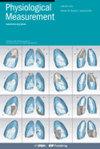用毫米波辐射测量健康人的血流量。
IF 2.3
4区 医学
Q3 BIOPHYSICS
引用次数: 0
摘要
目的外周动脉疾病(PAD)是一种渐进性心血管疾病,影响着美国 800 万到 1000 万成年人。PAD 会增加心血管事件的风险,但多达 50% 的 PAD 患者没有症状,也未得到诊断。在这项研究中,我们测试了一种名为 REFLO(Rapid Electromagnetic FLOw)的设备利用电磁辐射和动态热成像技术识别低血流量的能力,以实现对 PAD 的无创诊断。对于给定的射频能量吸收率,温度上升速度慢意味着组织的血流量大。这是由于血液的冷却作用。辐照后,温度下降速度慢则组织血流量低。在此,我们对基线、闭塞和闭塞后条件下的人类小腿进行了两组受控血流实验。主要结果在试验研究中,(N = 7)REFLO 在辐照阶段区分了基线和闭塞后,在辐照后阶段区分了基线和闭塞后。在可靠性研究(5 人,每人 3 次)中,双向方差分析显示,血流和受试者对皮肤加热和冷却速率有显著影响,而访问则没有影响。利用皮肤冷却率而不是加热率来区分血流速度更为一致。未来的修改和临床测试将旨在提高 REFLO 区分血流速度的能力,并评估其准确识别 PAD 的能力。本文章由计算机程序翻译,如有差异,请以英文原文为准。
Millimeter wave radiation to measure blood flow in healthy human subjects.
OBJECTIVE
Peripheral Artery Disease (PAD) is a progressive cardiovascular condition affecting 8-10 million adults in the United States. PAD elevates the risk of cardiovascular events, but up to 50% of people with PAD are asymptomatic and undiagnosed. In this study, we tested the ability of a device, REFLO (Rapid Electromagnetic FLOw), to identify low blood flow using electromagnetic radiation and dynamic thermography toward a non-invasive PAD diagnostic.
APPROACH
During REFLO radio frequency (RF) irradiation, the rate of temperature increase is a function of the rate of energy absorption and blood flow to the irradiated tissue. For a given rate of RF energy absorption, a slow rate of temperature increase implies a large blood flow rate to the tissue. This is due to the cooling effect of the blood. Post-irradiation, a slow rate of temperature decrease is associated with a low rate of blood flow to the tissue. Here, we performed two cohorts of controlled flow experiments on human calves during baseline, occluded, and post-occluded conditions. Nonlinear regression was used to fit temperature data and obtain the rate constant, which was used as a metric for blood flow.
MAIN RESULTS
In the pilot study, (N = 7) REFLO distinguished between baseline and post-occlusion during the irradiation phase, and between baseline and occlusion in the post-irradiation phase. In the reliability study, (N = 5 with 3 visits each), two-way ANOVA revealed that flow and subject significantly affected skin heating and cooling rates, while visit did not.
SIGNIFICANCE
Results suggest that MMW irradiation can be used to distinguish between blood flow rates in humans. Utilizing the rate of skin cooling rather than heating is more consistent for distinguishing flow. Future modifications and clinical testing will aim to improve REFLO's ability to distinguish between flow rates and evaluate its ability to accurately identify PAD.
求助全文
通过发布文献求助,成功后即可免费获取论文全文。
去求助
来源期刊

Physiological measurement
生物-工程:生物医学
CiteScore
5.50
自引率
9.40%
发文量
124
审稿时长
3 months
期刊介绍:
Physiological Measurement publishes papers about the quantitative assessment and visualization of physiological function in clinical research and practice, with an emphasis on the development of new methods of measurement and their validation.
Papers are published on topics including:
applied physiology in illness and health
electrical bioimpedance, optical and acoustic measurement techniques
advanced methods of time series and other data analysis
biomedical and clinical engineering
in-patient and ambulatory monitoring
point-of-care technologies
novel clinical measurements of cardiovascular, neurological, and musculoskeletal systems.
measurements in molecular, cellular and organ physiology and electrophysiology
physiological modeling and simulation
novel biomedical sensors, instruments, devices and systems
measurement standards and guidelines.
 求助内容:
求助内容: 应助结果提醒方式:
应助结果提醒方式:


